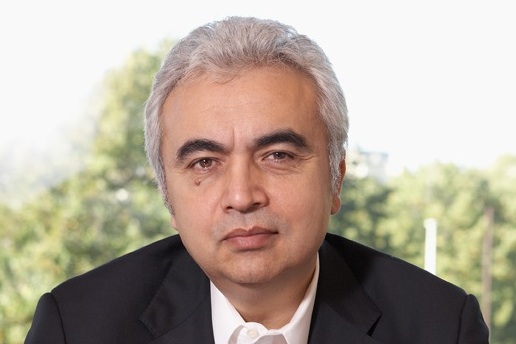
When the International Energy Agency (IEA) publishes its annual World Energy Outlook, government and industry leaders take notice. This year’s edition seized the attention not just of policymakers, but the mainstream press. “The foundations of the global energy system are shifting substantially and rapidly,” explained the IEA’s chief economist, Fatih Birol, at a MITEI-sponsored talk November 28th to share findings from the newly released report.
The World Energy Outlook offers strategic analysis of global energy markets and the impact of energy supply and demand on all nations. The 2012 publication, of which Birol is the lead author, describes major shakeups in energy supply and demand around the world, and their implications for energy security and economic development. Just for starters, Birol noted the reduction or complete phase-out of nuclear power in a number of countries, and the fact that all-time high oil prices are slowing a global economic recovery. In 2011, fossil fuel subsidies – Birol’s “Public Enemy #1 in the fight against climate change” – reached $523 billion globally, the same year CO2 emissions achieved a historical peak.
The Outlook predicted, according to Birol, that in 10 years’ time, the U.S. will be the largest oil and natural gas producer in the world, overtaking Saudi Arabia and Russia respectively. By 2020, said Birol, the U.S. will be a natural gas exporter, and oil imports will reach a minimum.
But newspaper reports celebrating future U.S. energy self-sufficiency got “only one part of the story,” said Birol. The Obama Administration’s recently introduced CAFE standards for improved fuel economy in cars will also significantly reduce demand for oil, so “the achievement will result not just from what is happening in North Dakota, but what will happen in Detroit.”
The dramatic energy boom in the U.S. is just part of a larger restructuring of the worldwide energy system, carrying major geopolitical consequences. As U.S. imports from the Middle East shrink “almost to zero,” said Birol, a new “silk road” is appearing between the Middle East and Asia, and soon, 90% of Gulf oil will be flowing to China and India. Decisions in these nations concerning their domestic energy markets “will affect the rest of the world,” asserted Birol.
“B to B,” Baghdad to Beijing, is emerging as a particularly critical trade relationship, said Birol. Iraq is poised for a major expansion of oil production, by 2020 doubling its current production of three million barrels per day. “Every second barrel of oil that comes to markets in the next 20 years will come from Iraq,” he said, and will be far cheaper than oil sold by Russia or Brazil. China, which places energy security near the top of its agenda, has been solidifying its trade links to Iraq, not simply purchasing oil but running oil fields there, noted Birol.
“China is dominating the game” in power generation as well. In the next 20 years it will add enough electric generating capacity to equal the current capacity of the U.S. and Japan combined. India is running close behind, and to fuel its power plants will be importing the largest share of the world’s coal by 2020. But in spite of this growth in power generation and related economic expansion, Birol remarked, “electricity consumption in India in 2035 will be equal to the electricity consumption in the U.S. in 1947.” In other words, “there will still be 100 years difference between rich and poor in the world.”
Birol believes that as “the center of gravity of the global energy system shifts to the East” and emerging economies drive a 70% increase in worldwide demand for electricity in the next two decades, there will be even greater jockeying for resources. In Japan and Europe, demand is intensifying for alternatives to nuclear energy. Prices for electricity and natural gas run much higher in these nations than in the U.S., and this puts additional pressure on their struggling economies.
Renewables will grow and eventually account for half of new global capacity, but their “benefits come at a cost,” said Birol. Global renewable energy subsidies will amount to $4.8 trillion between 2011 and 2035. Financial stress in many countries, especially in Europe, throws government subsidies for renewables in doubt.
This fundamental reconfiguration of global energy production and consumption, and the related rebalancing of economic and political power occurs against the backdrop of a heating planet, Birol pointed out. While many nations have committed to greenhouse gas emissions that limit global temperature increases to 2°C, IEA analysis shows that existing infrastructure “already eats up 80% of the emissions allowed us to stay under the 2° trajectory.” There is meager maneuvering room, and with little likelihood of an immediate change in current energy investment policies, or a price on carbon among key nations, chances of meeting this target evaporate as of 2017, he said.
Yet, after scrutinizing each country, sector by sector, IEA analysts detected an opportunity for addressing not just climate change, but issues of energy security and economic growth. It turns out, said Birol, that the world is using “only one third of its economically viable efficiency potential.” If nations adopt policies promoting energy efficiency in power generation, industry, transportation and building, they can boost employment and improve energy self-sufficiency, he said, without diminishing citizens’ standard of living. “Pushing the efficiency button” also buys the planet five more years to meet climate change emissions and temperature targets.
A few years ago, Birol predicted the unconventional energy revolution under way now in oil and gas production. “It is my hope to see such an unconventional energy revolution in energy efficiency,” he said. “The gains are within reach and essential to underpin a more secure and sustainable energy system.”
This article appears in the Spring 2013 issue of Energy Futures.